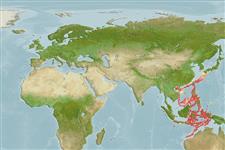Common names from other countries
Environment: milieu / climate zone / depth range / distribution range
экология
морской батидемерсальный; пределы глубины ? - 304 m (Ref. 58018). Deep-water; 35°N - 20°S, 105°E - 135°E
Indo-Pacific: Japan to the Philippines and the Arafura Sea. Also recorded from Darwin to North West Cape (Ref. 5978).
Size / Вес / Возраст
Maturity: Lm ? range ? - ? cm
Max length : 30.0 cm TL самец/пол неопределен; (Ref. 5978)
Краткое описание
определительные ключи | морфология | морфометрия
Large barbels on lower jaw. Orange-reddish in life with black bands in pectoral fin and black edge on dorsal fins.
A deepwater species (Ref. 9771). Found on the continental shelf (Ref. 75154). Bony scutes reduce commercial value (Ref. 9771).
Life cycle and mating behavior
Maturities | размножение | Spawnings | Egg(s) | Fecundities | личинки
Masuda, H., K. Amaoka, C. Araga, T. Uyeno and T. Yoshino, 1984. The fishes of the Japanese Archipelago. Vol. 1. Tokai University Press, Tokyo, Japan. 437 p. (text). (Ref. 559)
Статус Красного Списка МСОП (Ref. 130435)
CITES (Ref. 128078)
Not Evaluated
Угроза для людей
Harmless
Использование человеком
рыболовство: интереса не представляет
дополнительная информация
инструменты
Специальные отчеты
Скачать в формате XML
ресурсы в Интернет
Estimates based on models
Preferred temperature (Ref.
115969): 11.5 - 17.5, mean 13.8 (based on 50 cells).
Phylogenetic diversity index (Ref.
82804): PD
50 = 1.0000 [Uniqueness, from 0.5 = low to 2.0 = high].
Bayesian length-weight: a=0.00389 (0.00180 - 0.00842), b=3.12 (2.94 - 3.30), in cm Total Length, based on all LWR estimates for this body shape (Ref.
93245).
Trophic level (Ref.
69278): 3.5 ±0.3 se; based on size and trophs of closest relatives
устойчивость к внешним воздействиям (Ref.
120179): средний (среднего размера), минимальное время удвоения популяции 1.4-4.4 года (Preliminary K or Fecundity.).
Fishing Vulnerability (Ref.
59153): Low vulnerability (20 of 100).
